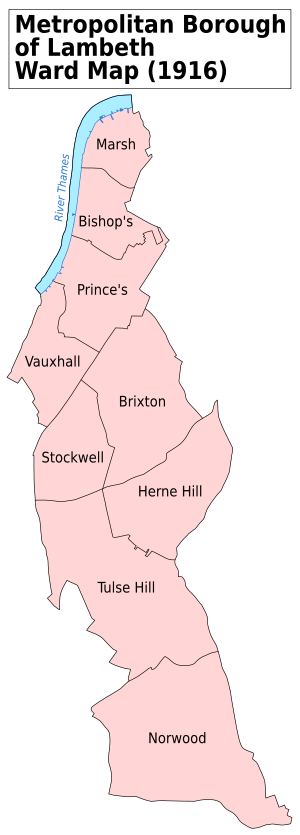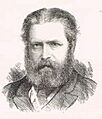Lambeth North (UK Parliament constituency) facts for kids
Quick facts for kids {{{Name}}}[[{{{Type}}} constituency]] |
|
|---|---|
| [[Image:{{{Map1}}}Constituency.svg|120px|]] [[Image:England{{{Map2}}}.svg|120px|]] |
|
| {{{Name}}} shown within [[{{{Entity}}}]], and {{{Entity}}} shown within England | |
| Created: | {{{Year}}} |
| MP: | {{{MP}}} |
| Party: | {{{Party}}} |
| Type: | House of Commons |
| County: | [[{{{County}}}]] |
| EP constituency: | [[{{{EP}}} (European Parliament constituency)|{{{EP}}}]] |
Lambeth North was a special area in South London, around the Lambeth district. This area was called a borough constituency, which means it was set up to elect one person to represent its people in the UK Parliament.
The person elected was known as a Member of Parliament (MP). They would go to the House of Commons, which is where MPs meet to make laws for the country. The MP for Lambeth North was chosen using the first past the post system. This means the candidate who got the most votes won the election.
Contents
A Look Back at Lambeth North
The Lambeth North constituency was created in 1885. Before that, the larger Lambeth area had two MPs. But a new law, the Redistribution of Seats Act 1885, split it into smaller parts, and Lambeth North was one of them.
This constituency existed for many years, but it was eventually removed in 1950. At that time, its area became part of a new constituency called Vauxhall.
What Area Did it Cover?
The exact area that Lambeth North covered changed a little over time.
Early Boundaries (1885 - 1918)
From 1885 to 1918, Lambeth North included three specific parts, or wards, of the Lambeth parish. These wards were called Bishop's, North Marsh, and South Marsh. These were the same areas used to elect members to the local council, known as the Lambeth Vestry.
Later Boundaries (1918 - 1950)
In 1918, a new law called the Representation of the People Act 1918 changed how constituencies were set up in London. They started using the areas of the new Metropolitan Boroughs, which had replaced the old vestries.
After 1918, Lambeth North included Bishop's Ward, Marsh Ward, and a part of Prince's Ward within the Metropolitan Borough of Lambeth. This part of Prince's Ward was defined by a line running from Vauxhall Bridge along Upper Kennington Lane and Lower Kennington Lane to Newington Butts.
Who Represented Lambeth North?
A Member of Parliament (MP) is a person elected to represent their local area in the House of Commons. They speak for the people in their constituency and help make laws for the country. Here are the MPs who represented Lambeth North:
| Election | Member | Party | |
|---|---|---|---|
| 1885 | Sir Charles Craufurd Fraser | Conservative | |
| 1892 | Francis Coldwells | Liberal | |
| 1895 | Sir Henry Morton Stanley | Liberal Unionist | |
| 1900 | Frederick William Horner | Conservative | |
| 1906 | Horatio Myer | Liberal | |
| Jan 1910 | Sir William Houghton-Gastrell | Conservative | |
| 1918 | Frank Briant | Liberal | |
| 1929 | George Strauss | Labour | |
| 1931 | Frank Briant | Liberal | |
| 1934 by-election | George Strauss | Labour | |
| 1950 | constituency abolished | ||
Election Results: A Quick Look
Elections are how people choose their representatives. In Lambeth North, several elections took place over the years. Different political parties, like the Conservative, Liberal, and Labour parties, put forward candidates. The person with the most votes would become the MP.
For example, in the 1885 election, Sir Charles Craufurd Fraser from the Conservative Party won. Later, in 1892, Francis Coldwells from the Liberal Party became the MP. The seat changed hands between different parties several times throughout its history, showing how voters' preferences could shift.
One notable MP was George Strauss, who represented Lambeth North for the Labour Party in the late 1920s and again in the 1930s and 1940s. He was the last MP for Lambeth North before the constituency was abolished in 1950.
Images for kids









